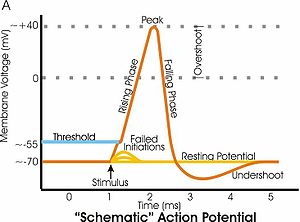
Back فرط الاستقطاب Arabic هایپر پولاریزاسیون (بیولوژی) AZB Repolarització Catalan Hyperpolarizace Czech Hyperpolarisering (membran) Danish Hyperpolarisation (Biologie) German Hiperpolarización Spanish Hyperpolarisaatio Finnish 過分極 (生物学) Japanese 과분극 Korean
This article needs additional citations for verification. (May 2013) |

Hyperpolarization is a change in a cell's membrane potential that makes it more negative. Cells typically have a negative resting potential, with neuronal action potentials depolarizing the membrane. When the resting membrane potential is made more negative, it increases the minimum stimulus needed to surpass the needed threshold. Neurons naturally become hyperpolarized at the end of an action potential, which is often referred to as the relative refractory period. Relative refractory periods typically last 2 milliseconds, during which a stronger stimulus is needed to trigger another action potential. Cells can also become hyperpolarized depending on channels and receptors present on the membrane, which can have an inhibitory effect.
Hyperpolarization is often caused by efflux of K+ (a cation) through K+ channels, or influx of Cl– (an anion) through Cl– channels. On the other hand, influx of cations, e.g. Na+ through Na+ channels or Ca2+ through Ca2+ channels, inhibits hyperpolarization. If a cell has Na+ or Ca2+ currents at rest, then inhibition of those currents will also result in hyperpolarization. This voltage-gated ion channel response is how the hyperpolarization state is achieved. [1]
- ^ Pack, Phillip E. "Cliffs AP Biology 3rd Edition"